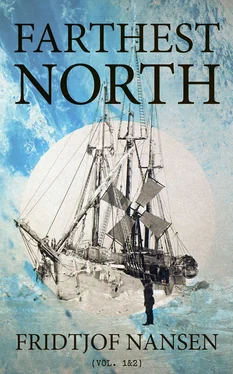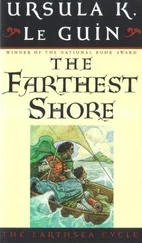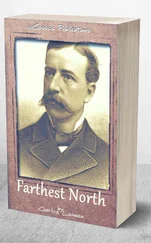Everything was of course done to make the sides of the ship as strong as possible. The frame timbers were of choice Italian oak that had originally been intended for the Norwegian navy, and had lain under cover at Horten for 30 years. They were all grown to shape, and 10–11 inches thick. The frames were built in two courses or tiers, closely wrought together, and connected by bolts, some of which were riveted. Over each joint flat iron bands were placed. The frames were about 21 inches (56 cm.) wide, and were placed close together, with only about an inch or an inch and a half between; and these interstices were filled with pitch and sawdust mixed, from the keel to a little distance above the water-line, in order to keep the ship moderately water-tight, even should the outer skin be chafed through.
The outside planking consists of three layers. The inner one is of oak, 3 inches thick, fastened with spikes and carefully calked; outside this another oak sheathing, 4 inches thick, fastened with through bolts and calked; and outside these comes the ice-skin of greenheart, which like the other planking runs right down to the keel. At the water-line it is 6 inches thick, gradually diminishing towards the bottom to 3 inches. It is fastened with nails and jagged bolts, and not with through bolts; so that if the ice had stripped off the whole of the ice sheathing the hull of the ship would not have suffered any great damage. The lining inside the frame timbers is of pitch-pine planks, some 4, some 8 inches thick; it was also carefully calked once or twice.
The total thickness of the ship’s sides is, therefore, from 24 to 28 inches of solid water-tight wood. It will readily be understood that such a ship’s side, with its rounded form, would of itself offer a very good resistance to the ice; but to make it still stronger the inside was shored up in every possible way, so that the hold looks like a cobweb of balks, stanchions, and braces. In the first place, there are two rows of beams, the upper deck and between decks, principally of solid oak, partly also of pitch pine; and all of these are further connected with each other, as well as with the sides of the ship, by numerous supports. The accompanying diagrams will show how they are arranged. The diagonal stays are, of course, placed as nearly as possible at right angles to the sides of the ship, so as to strengthen them against external pressure and to distribute its force. The vertical stanchions between both tiers of beams and between the lower beams and keelson are admirably adapted for this latter object. All are connected together with strong knees and iron fastenings, so that the whole becomes, as it were, a single coherent mass. It should be borne in mind that, while in former expeditions it was thought sufficient to give a couple of beams amidships some extra strengthening, every single cross beam in the Fram was stayed in the manner described and depicted.
In the engine-room there was, of course, no space for supports in the middle, but in their place two stay ends were fixed on either side. The beams of the lower deck were placed a little under the water-line, where the ice pressure would be severest. In the after-hold these beams had to be raised a little to give room for the engine. The upper deck aft, therefore, was somewhat higher than the main deck, and the ship had a poop or half-deck, under which were the cabins for all the members of the expedition, and also the cooking-galley. Strong iron riders were worked in for the whole length of the ship in the spaces between the beams, extending in one length from the clamp under the upper deck nearly to the keelson. The keelson was in two tiers and about 31 inches (80 cm.) high, save in the engine-room, where the height of the room only allows one tier. The keel consists of two heavy American elm logs 14 inches square; but, as has been mentioned, so built in that only 3 inches protrude below the outer planking. The sides of the hull are rounded downward to the keel, so that a transverse section at the midship frame reminds one forcibly of half a cocoanut cut in two. The higher the ship is lifted out of the water, the heavier does she, of course, become, and the greater her pressure on the ice, but for the above reason the easier also does it become for the ice to lift. To obviate much heeling, in case the hull should be lifted very high, the bottom was made flat, and this proved to be an excellent idea. I endeavored to determine experimentally the friction of ice against wood, and taking into account the strength of the ship, and the angle of her sides with the surface of the water, I came to the conclusion that her strength must be many times sufficient to withstand the pressure necessary to lift her. This calculation was amply borne out by experience.
The principal dimensions of the ship were as follows: Length of keel, 102 feet; length of water-line, 113 feet; length from stem to stern on deck, 128 feet; extreme breadth, 36 feet; breadth of water-line, exclusive of ice-skin, 34 feet; depth, 17 feet; draught of water with light cargo, 12½ feet; displacement with light cargo, 530 tons; with heavy cargo the draught is over 15 feet and the displacement is 800 tons; there is a freeboard of about 3 feet 6 inches. The hull, with boilers filled, was calculated to weigh about 420 tons, and with 800 tons displacement there should, therefore, be spare carrying power for coal and other cargo to the amount of 380 tons. Thus, in addition to the requisite provisions for dogs and men for more than five years, we could carry coal for four months’ steaming at full speed, which was more than sufficient for such an expedition as this.
As regards the rigging, the most important object was to have it as simple and as strong as possible, and at the same time so contrived as to offer the least possible resistance to the wind while the ship was under steam. With our small crew it was, moreover, of the last importance that it should be easy to work from deck. For this reason the Fram was rigged as a three-masted fore-and-aft schooner. Several of our old Arctic skippers disapproved of this arrangement. They had always been used to sail with square-rigged ships, and, with the conservatism peculiar to their class, were of opinion that what they had used was the only thing that could be used in the ice. However, the rig we chose was unquestionably the best for our purpose. In addition to the ordinary fore-and-aft sails we had two movable yards on the foremast for a square foresail and topsail. As the yards were attached to a sliding truss they could easily be hauled down when not in use. The ship’s lower masts were tolerably high and massive. The mainmast was about 80 feet high, the maintopmast was 50 feet high, and the crow’s-nest on the top was about 102 feet (32 m.) above the water. It was important to have this as high as possible, so as to have a more extended view when it came to picking our way through the ice. The aggregate sail area was about 6000 square feet.
The ship’s engine, a triple expansion, was made with particular care. The work was done at the Akers Mechanical Factory, and Engineer Norbeck deserves especial credit for its construction. With his quick insight he foresaw the various possibilities that might occur, and took precautions against them. The triple-expansion system was chosen as being the most economical in the consumption of coal; but as it might happen that one or other of the cylinders should get out of order, it was arranged, by means of separate pipes, that any of the cylinders could be cut off, and thus the other two, or, at a pinch, even one alone, could be used. In this way the engine, by the mere turning of a cock or two, could be changed at will into a compound high-pressure or low-pressure engine. Although nothing ever went wrong with any of the cylinders, this arrangement was frequently used with advantage. By using the engine as a compound one, we could, for instance, give the Fram greater speed for a short time, and when occasion demanded we often took this means of forcing our way through the ice. The engine was of 220 indicated horse-power, and we could in calm weather with a light cargo attain a speed of 6 or 7 knots.
Читать дальше












